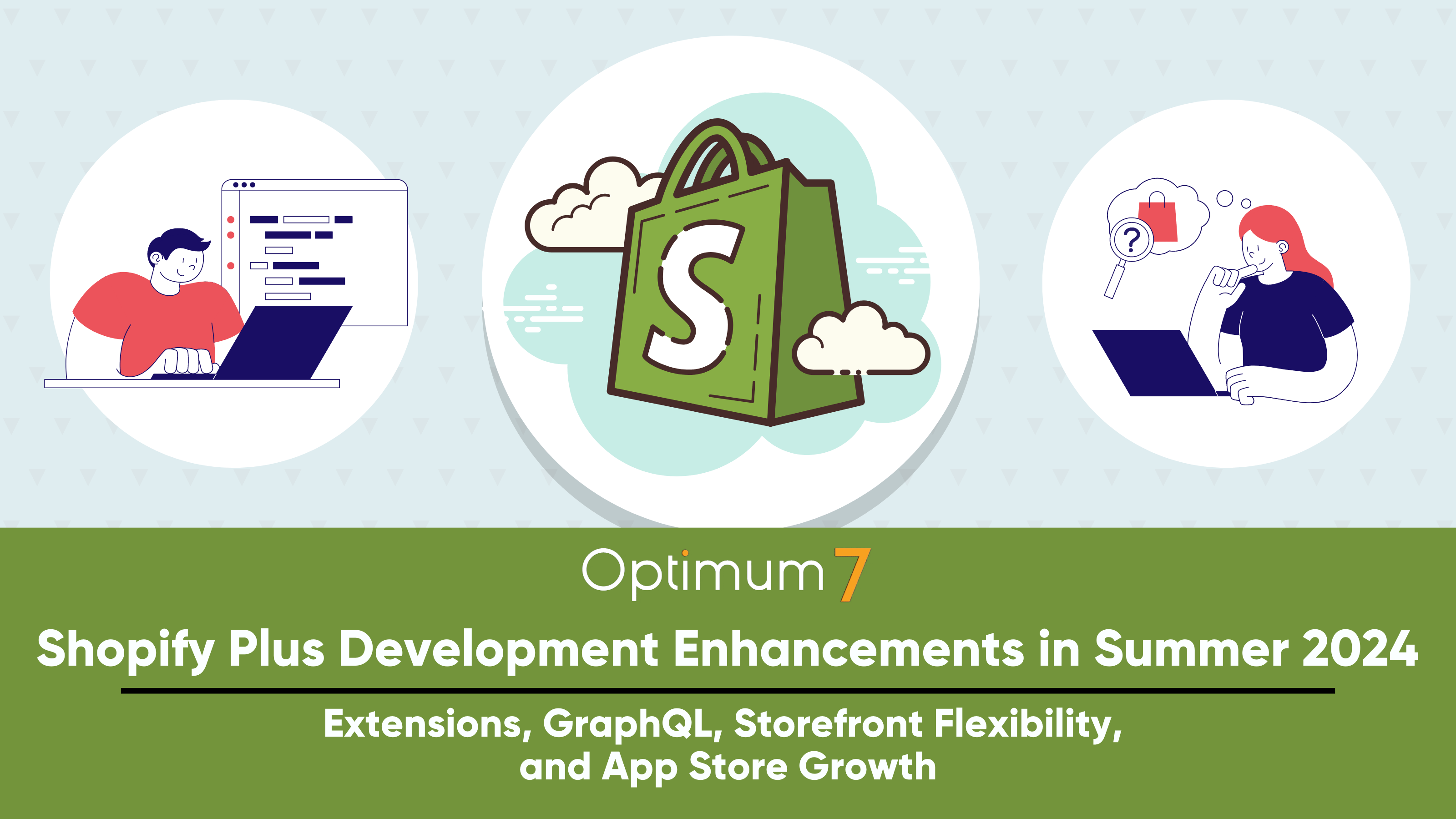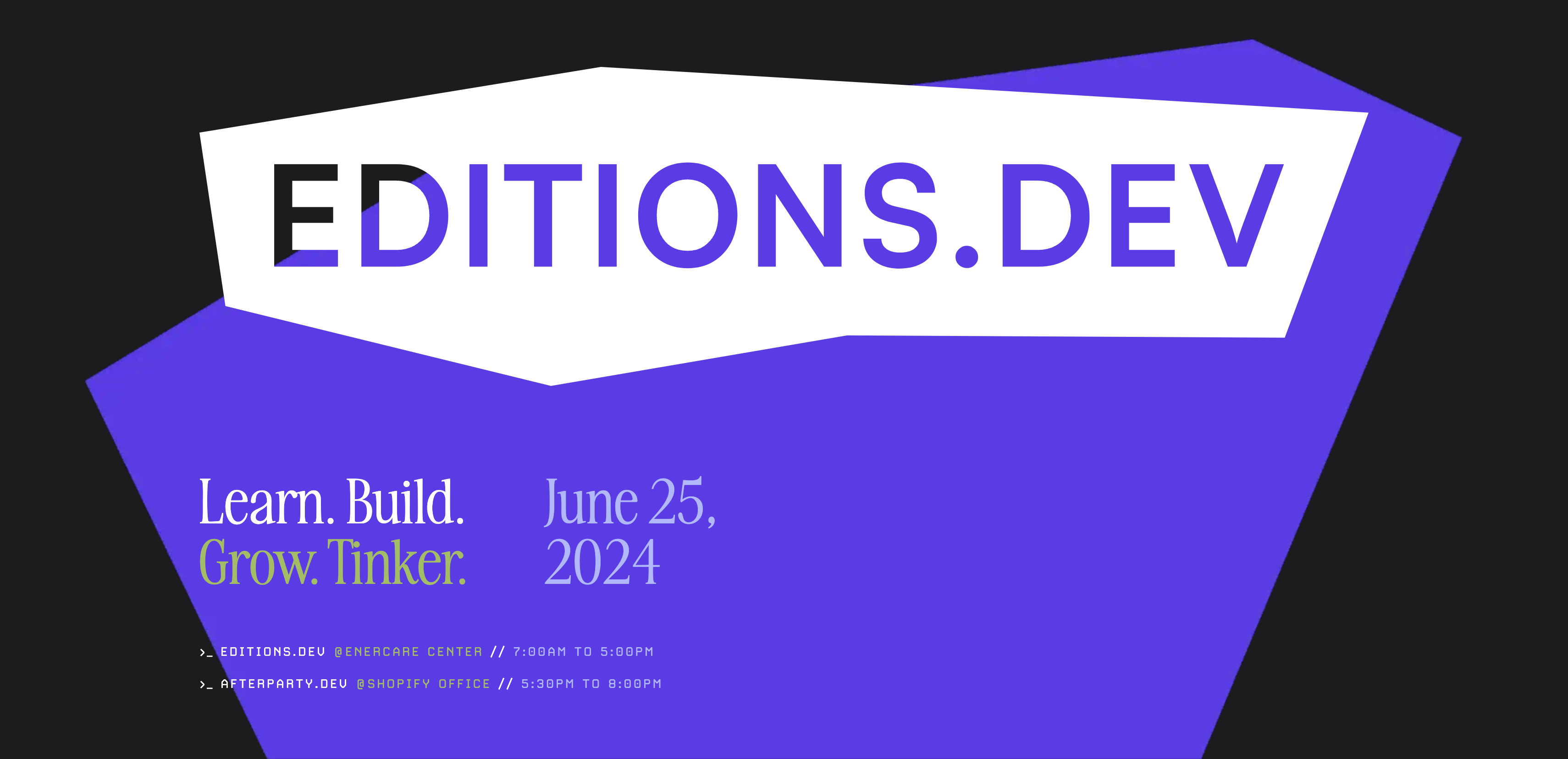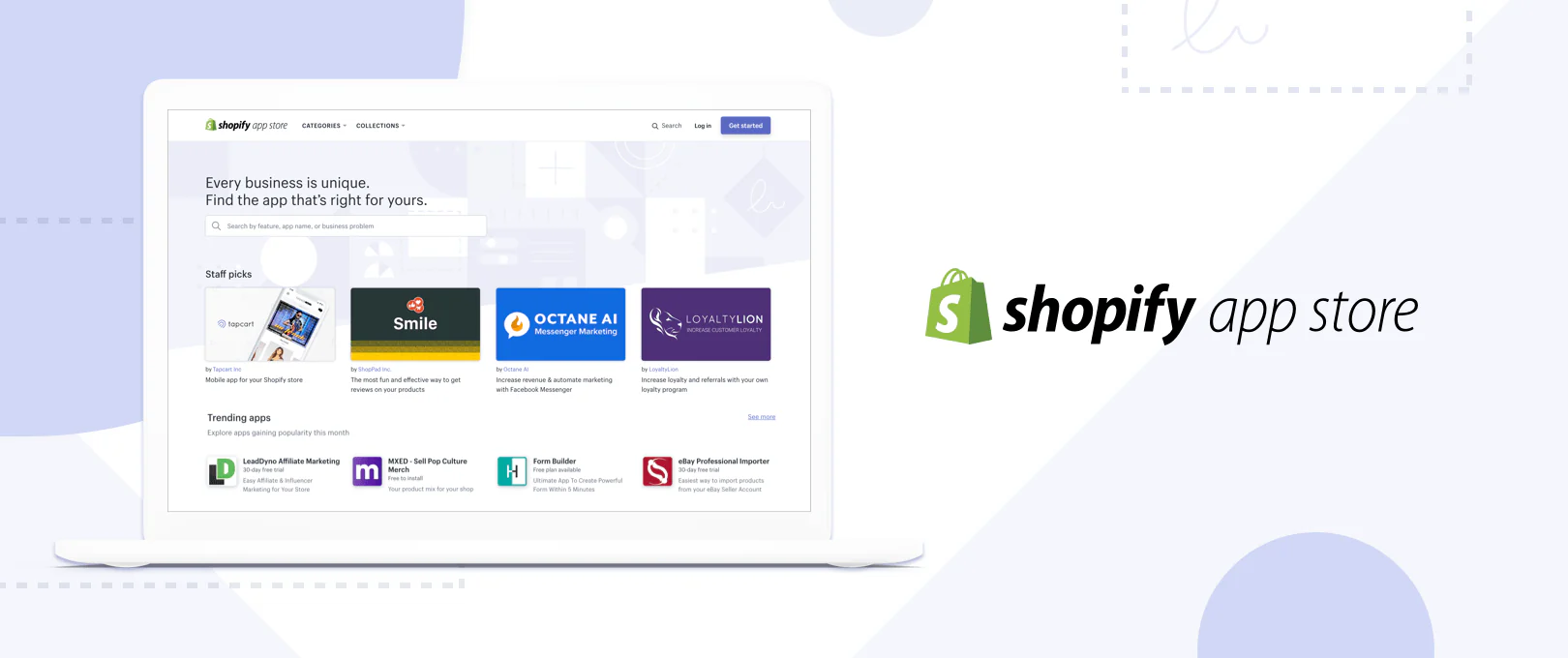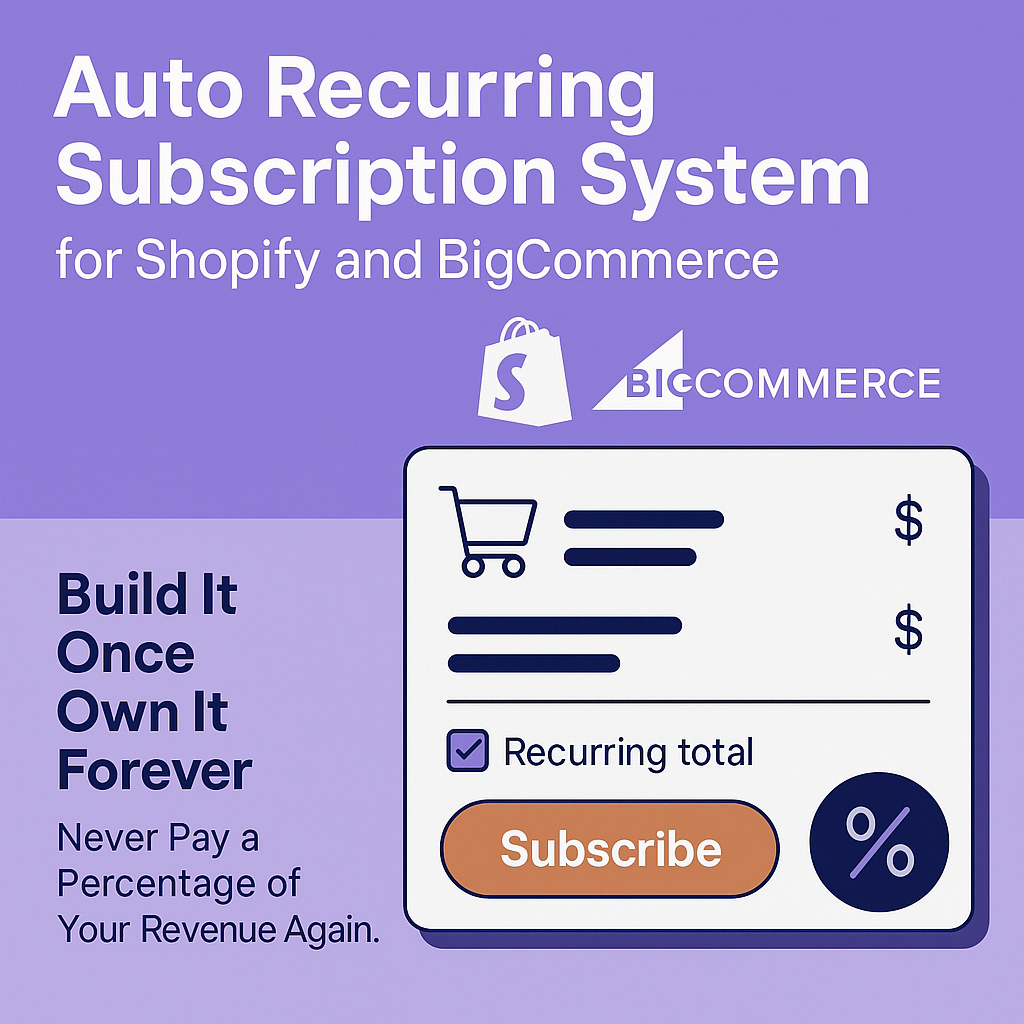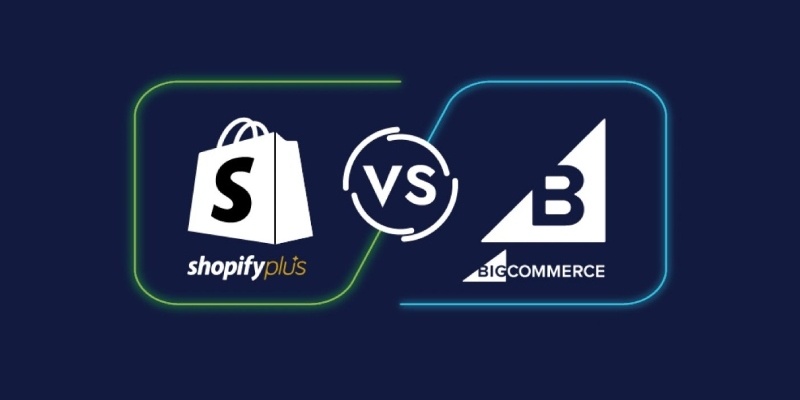In 2024, Shopify surpassed $1.5 billion in revenue and continues to support over 2.1 million merchants globally. The platform powers businesses in more than 175 countries, processing billions of dollars in sales each year. At yesterday’s Editions.dev conference, Shopify unveiled a series of groundbreaking updates set to transform the Shopify Plus platform this summer. These enhancements, particularly relevant for a Shopify Plus development company, aim to streamline the development process, improve data handling, expand storefront customization options, and drive significant growth within the App Store ecosystem.
These updates cover four key areas:
- Extensions
- GraphQL
- Storefront Flexibility
- App Store Growth
Each of these areas has seen significant improvements designed to provide developers with more powerful tools and merchants with more flexible and customizable storefronts. Let’s delve into the details of these enhancements.
Editions.dev Conference: The Future of Shopify
The Editions.dev conference, hosted by Shopify, took place on June 25, 2024, in Toronto, Canada. This developer-focused event, part of Shopify’s biannual “Editions” series, showcased new updates and features tailored for developers building apps, themes, and custom storefronts on Shopify.
Key Highlights of Editions.dev 2024
- Developer-Focused Content: The event featured technical workshops, demo talks, and hands-on sessions with Shopify’s latest tools and APIs. Attendees engaged in partner talks, round tables, and meetups to collaborate with Shopify product teams and other developers.
- New Tools and Features:
- .dev Assistant: An AI-powered tool for generating GraphQL queries and mutations from natural language instructions.
- Shopify CLI: The latest version unifies commands for building apps, themes, and Hydrogen storefronts.
- GraphQL API Enhancements: Support for up to 2,000 product variants, easing the management of large catalogs.
- Workshops and Hands-On Sessions: Workshops allowed developers to experiment with Shopify Extensions, APIs, and other tools, receiving direct feedback.
- Accessibility and Inclusivity: The venue, Enercare Centre, was fully accessible with gender-neutral washrooms, prayer rooms, and parent rooms. Mainstage programming included closed captioning.
- Networking and Community Building: The conference provided a platform for developers to connect with Shopify’s product teams and community members, fostering collaboration and innovation.
Editions.dev 2024 offered developers the latest tools, updates, and opportunities to improve and level up their playground and innovate within the Shopify ecosystem.
1. Enhancements and Future Directions for Shopify Development
The Editions.dev conference highlighted several key updates aimed at improving the development process on Shopify. These enhancements focus on streamlining workflows, advancing data management, and expanding customization options, all designed to empower developers and enrich the overall platform experience.
1.1. Release Process
One of the standout improvements in Shopify’s development process is the refined release mechanism. Shopify now utilizes a method where all modules are rolled up into a single binary for distribution. This approach offers several advantages:
Efficiency: The binary can be distributed to all shops quickly, ensuring that updates are implemented swiftly across the platform.
Simplicity in Rollback: The immutability of the modules means that if any issues arise post-deployment, rolling back to a previous version is straightforward and hassle-free. This minimizes downtime and maintains stability, allowing merchants to continue their operations without significant interruptions.
This optimized release process underscores Shopify’s commitment to maintaining a stable and efficient platform for both developers and merchants, reducing the complexity traditionally associated with updates and rollbacks.
1.2. Data Handling
Managing data effectively is crucial for any eCommerce platform, and Shopify has made significant strides in this area. Developers often face challenges when working with meta-fields and meta-objects, which are essential for storing app configurations or state data. These elements, while powerful, have been historically challenging to manage due to their complexity.
Shopify’s latest updates introduce a simplified method for defining and deploying meta-object definitions. Key improvements include:
Streamlined Schema Definition: Developers can now define a schema for meta-objects more easily, reducing the amount of manual configuration required.
Automated Deployment: Once defined, these schemas can be deployed across all shops where the app is installed, ensuring consistency and reducing the need for manual migrations.
These enhancements aim to improve the overall developer experience by minimizing the backend data management workload, allowing developers to focus more on building and enhancing their apps. By addressing these common pain points, Shopify is making it easier for developers to implement and maintain their app configurations, which in turn benefits merchants through more reliable and feature-rich applications.
1.3. GraphQL Improvements
GraphQL has been a game-changer for many developers working on Shopify, and recent enhancements have made it even more powerful and user-friendly. Shopify has focused on making GraphQL the primary API for all interactions, with several key improvements rolled out in the past six months.
Why GraphQL? GraphQL was chosen for its flexibility and efficiency in handling queries and mutations. Unlike REST, which requires multiple endpoints for different data sets, GraphQL allows developers to request exactly what they need in a single query, reducing the amount of data transferred and improving performance.
Recent Improvements:
- Enhanced Tooling: Developers now have access to better tools for working with GraphQL, making it easier to build and debug queries.
- Performance Boosts: Significant efforts have been made to optimize GraphQL performance, ensuring faster response times and more efficient data handling.
- Complete API Coverage: Shopify is on track to have the admin GraphQL API cover the entire platform by the end of the year. This means that everything that can be done via REST will also be possible with GraphQL, and often more efficiently.
These improvements not only streamline the development process but also ensure that developers can build more powerful and responsive applications. The transition to GraphQL is set to eclipse REST, providing a more unified and efficient way to interact with Shopify’s platform.
1.4. Future of Extensions
Extensions are becoming increasingly central to Shopify’s customization capabilities, allowing developers to tailor the platform to meet specific merchant needs. The future of Shopify extensions looks promising, with several new developments aimed at expanding their use beyond checkout to other areas such as POS and admin.
Key Features:
- Comprehensive Customization: Extensions will enable deep customization across various services, not just limited to checkout. This includes POS systems, customer accounts, and admin functionalities.
- Better Data Protection and Compliance: By isolating code inside sandboxes, Shopify ensures that extensions integrate well with privacy and permission frameworks. This enhances data protection and compliance with global regulations, such as e-privacy in Europe and PCI for card industry standards.
- Performance Optimization: Controlling both the hosting and fetching of data for apps allows Shopify to optimize performance continuously, ensuring that apps feel snappy and responsive.
Upgrade Safety: One of the most significant advancements is the concept of upgrade safety. This means that custom apps can run side by side with native code, using the same UI components and data APIs. This approach simplifies API versioning and ensures that both merchant and buyer flows remain consistent and familiar.
The emphasis on extensions highlights Shopify’s commitment to providing a flexible and secure platform that can be customized extensively without compromising performance or compliance. This direction is expected to open up numerous opportunities for developers to create high-quality, innovative apps that meet the evolving needs of merchants.
1.5. Checkout Customization Demo
Shopify’s advancements in checkout customization demonstrate their commitment to providing a flexible and customizable platform. A recent demo highlighted how developers can use Shopify functions, UI extensions, and metafields to create a seamless and enhanced checkout experience.
Example Highlight: The demo showcased a store offering various local pickup options, including a new premium curbside pickup service. This service was designed to add value by providing additional features such as an extra-wide loading dock, dedicated staff for loading, and a protective lining for the car.
Implementation Details:
- Shopify Functions: These were used to manage backend logic efficiently. For instance, the function code was responsible for filtering out locations that had reached their capacity for the day, ensuring that only available pickup locations were displayed to the customer.
- UI Extensions: These enhanced the visual presentation of the new service within the checkout process. The UI extensions allowed developers to dynamically highlight the premium curbside pickup option, making it more visible and attractive to customers.
- Metafields: Metafields were used to store and manage the additional data required for the premium service, such as whether a location supports the premium pickup and the operating hours for this service. This shared state ensured consistency across the checkout process.
Benefits:
- Enhanced Buyer Experience: By integrating additional services directly into the checkout flow, merchants can offer more tailored and valuable options to their customers. This not only improves customer satisfaction but also increases the likelihood of upsells.
- Seamless Integration: The use of Shopify functions and UI extensions ensures that these customizations are robust and maintainable. The combination of server-side logic with dynamic UI elements allows for a cohesive and interactive user experience.
The demo effectively illustrated how developers can create sophisticated and user-friendly customizations that enhance the overall shopping experience. By leveraging Shopify’s latest tools, merchants can differentiate their services and provide added value to their customers, directly within the checkout process.
1.6. Customer Account Extensions
The ability to customize customer accounts has been significantly enhanced with new features and capabilities. Shopify now allows developers to use the customer account editor for app blocks and extension collections, providing greater flexibility in managing customer information and interactions.
New Capabilities:
- App Blocks: Developers can now integrate app blocks directly into customer accounts. This feature enables the addition of personalized and functional elements, such as loyalty points, personalized recommendations, and account-specific promotions.
- Extension Collections: Developers can group multiple extensions into collections, which can be managed and deployed together. This simplifies the process of maintaining and updating complex customizations, ensuring that all related components work seamlessly together.
Examples of Use:
- Loyalty Programs: Imagine enhancing a loyalty program with rich, interactive app blocks. These blocks can show detailed loyalty points balance, available rewards, and options for redeeming points. Integrating these elements into both the customer account and checkout pages keeps the experience cohesive and engaging, making customers feel valued and more likely to return.
- Customer Dashboards: A custom dashboard that provides your customers with a clear, intuitive view of their order history, preferences, and personalized product recommendations. This not only makes account management easier but also creates a more personalized shopping experience, encouraging repeat purchases and boosting customer satisfaction.
Administrative Enhancements:
- Increased Action and Block Extensions in Admin: Shopify has significantly increased the number of action and block extensions available in the admin interface. This expansion allows merchants to perform tasks more efficiently without needing to switch pages or navigate through multiple steps. For instance, a new print extension enables apps to generate various types of documents directly within the admin, streamlining processes such as invoicing and shipping label creation.
These updates empower developers to create highly customized and functional customer account experiences. By providing tools that enhance both the backend logic and the frontend user interface, Shopify ensures that developers can build apps that meet the specific needs of merchants and their customers.
1.7. Future Improvements
Shopify is continuously working on refining its platform, and several areas have been identified for future improvements. These enhancements are aimed at making the development process smoother, the tools more powerful, and the user experience even better.
UI Extension Settings: One of the key areas for improvement is the UI extension settings. Currently, Shopify offers a simple static schema for settings, which, while functional, lacks the sophistication and flexibility that some developers need.
- Expressive Settings: Shopify plans to make UI extension settings more expressive and dynamic. This means developers will be able to create more complex and interactive settings interfaces, allowing for greater customization and control over how their extensions behave.
- Dynamic UI: The improved settings will support dynamic user interfaces, which can adapt based on user input and other factors. This will enable developers to build more intuitive and responsive applications.
Enhanced UI Components: Another focus area is the enhancement of UI components. Shopify recognizes that some of the existing components need to be more sophisticated to meet the evolving needs of developers and merchants.
- Improved Components: Shopify is working on making UI components more versatile and powerful, ensuring they can handle a wider range of use cases and provide a better user experience.
- Consistency and Usability: These improvements will also aim to ensure that UI components are consistent across the platform, making it easier for developers to create cohesive and user-friendly applications.
Encouragement to Build High-Quality Apps: Shopify is encouraging developers to build high-quality apps using the latest tools and extensions. This push is reminiscent of the early days of native mobile app development, where the quality and functionality of apps played a crucial role in their success.
- Quality Standards: Developers are urged to adhere to high standards of design, reliability, and performance, ensuring that their apps meet the needs of merchants and provide a superior user experience.
- Long-Term Success: By building high-quality apps, developers can position themselves for long-term success in the Shopify ecosystem, gaining trust and recognition from merchants.
These future improvements highlight Shopify’s commitment to providing a robust and versatile platform that continues to evolve in response to the needs of its developers and merchants.
2. Enhancements and Opportunities in Shopify’s App and Storefront Ecosystem
At the Editions.dev conference, Shopify unveiled a host of new tools and features designed to enhance the app and storefront ecosystem. These updates provide developers with more powerful capabilities and open up new opportunities for creating innovative and high-quality apps that meet the evolving needs of merchants.
2.1. Storefront Flexibility
Flexibility in storefront design and functionality is paramount for merchants who want to express their brand uniquely. Shopify has introduced several features to enhance this flexibility, ensuring that every merchant can create a distinctive online presence that aligns with their brand identity.
Introduction of Style Settings: One of the key new features is the introduction of style settings. This feature simplifies the process of applying styles to elements within themes. Merchants no longer need to duplicate settings to achieve consistent styling across different parts of their store.
- Unified Styling: Merchants can now define styles once and apply them store-wide, reducing redundancy and potential errors.
- Ease of Use: Shopify handles the CSS, allowing merchants to specify which elements to style and providing default settings using CSS notation. This includes support for media queries to ensure that styles are responsive and look great on any device.
Benefits:
- Streamlined Design Process: Style settings make it easier for merchants to manage the visual aspects of their storefront without needing extensive technical knowledge.
- Consistent Branding: Ensuring consistent styling across the entire storefront helps maintain a cohesive brand identity.
- Responsive Design: Built-in support for media queries ensures that the storefront adapts seamlessly to different screen sizes, providing a better user experience.
Theme Blocks: In addition to style settings, Shopify has redefined theme structure with the introduction of theme blocks. Released in January, theme blocks have become the new building blocks of the online store, replacing the need for repetitive code.
- Simplified Theme Development: Blocks allow for more modular and reusable code, making theme development and maintenance more efficient.
- Enhanced Flexibility: Merchants can easily drag and drop blocks to customize their storefront layout, creating infinite variations without needing to modify the underlying code.
These enhancements in storefront flexibility empower merchants to create more engaging and visually appealing online stores, while also simplifying the design and development process.
2.2. Hydrogen Visual Editor
The Hydrogen Visual Editor is one of Shopify’s most exciting new tools, designed to improve productivity for developers using the headless approach. Powered by Utopia, this visual editor brings several advantages, making it easier to build and maintain dynamic, high-performance storefronts.
Key Features:
- Visual Interface: The Hydrogen Visual Editor offers a natural, intuitive editing interface that allows developers and designers to work seamlessly together. This reduces the need for extensive coding and makes it easier to visualize changes in real-time.
- Clean Code Output: One of the standout features of the Hydrogen Visual Editor is its ability to produce clean, maintainable code. This ensures that even complex storefronts remain easy to manage and update.
- Integration with Third-Party Data Sources: The editor supports integration with various third-party data sources, allowing developers to pull in data from multiple systems. This flexibility is crucial for creating dynamic, data-driven storefronts.
Developer Advantages:
- Increased Productivity: By simplifying the development process and reducing the need for manual coding, the Hydrogen Visual Editor significantly boosts productivity. Developers can focus on building features and refining the user experience rather than getting bogged down in code.
- Better Collaboration: The visual interface facilitates better collaboration between developers and designers. Changes can be made quickly and reviewed visually, ensuring that everyone is on the same page.
- Enhanced Flexibility: The ability to integrate with third-party data sources means that developers can build more versatile and dynamic storefronts. This opens up new possibilities for personalization and customization, enhancing the overall shopping experience.
2.3. Shopify’s Two Storefront Platforms
Shopify supports two primary storefront platforms: Liquid and Hydrogen. Each platform has its unique strengths, and Shopify is committed to investing in both paths to provide developers with the tools they need, regardless of their preferences or requirements.
Liquid Platform:
- Simplicity and Ease of Use: Liquid is the traditional platform used by most Shopify stores. It is designed to be simple and easy to use, making it ideal for developers who prefer not to manage server-side code.
- Extensive Theme Support: Liquid themes are widely available and supported, providing a vast array of templates and customization options for merchants.
- Robust Community and Resources: The Liquid platform benefits from a robust community and extensive documentation, making it easier for developers to find support and resources.
Hydrogen Platform:
- Ultimate Flexibility: Hydrogen is Shopify’s headless commerce solution, offering developers ultimate flexibility by allowing them to control the entire stack. This is particularly useful for complex storefronts that require server control or integration with other systems.
- Custom Routing and Integrations: With Hydrogen, developers can define custom routing and integrate seamlessly with third-party systems like CMSs, ERPs, and more.
- Advanced Performance Optimization: Hydrogen is designed for high performance, making it suitable for large-scale, dynamic storefronts that require fast load times and responsive interactions.
Choosing the Right Platform:
- Use Liquid If: You prefer a simpler, more straightforward development process with plenty of ready-made themes and support. Liquid is perfect for merchants who want to get their store up and running quickly without worrying about server management.
- Use Hydrogen If: You need more control over your storefront’s architecture and want to leverage the flexibility of a headless solution. Hydrogen is ideal for developers building complex, highly customized storefronts that need to integrate with various backend systems.
By investing heavily in both Liquid and Hydrogen, Shopify ensures that developers have the best tools available, no matter their specific needs or preferences. This dual approach highlights Shopify’s commitment to supporting a wide range of eCommerce scenarios, from simple setups to highly sophisticated storefronts.
2.4. Growth Opportunities in the App Store
The Shopify App Store is a bustling marketplace with over 13,000 apps, presenting tremendous growth opportunities for developers. Whether you’re an established developer or just starting, the App Store offers various avenues to create, market, and monetize your apps.
Current Landscape:
- Diverse Ecosystem: With a wide range of apps covering everything from marketing automation to inventory management, the App Store caters to the diverse needs of Shopify merchants.
- Significant Usage: On average, merchants use six apps to enhance their store functionality, with this number rising to twelve for Shopify Plus merchants. This high adoption rate highlights the importance of quality apps in the Shopify ecosystem.
Opportunities for Developers:
- New Developers: There are ample opportunities for new developers to break into the market by focusing on niche areas or improving upon existing app functionalities. Examples include the recent success of Essential Announcements Bar, which excelled in a mature category by offering a high-quality solution.
- Small Developers: Smaller developers have a chance to compete with bigger players by building high-quality, reliable apps. By meeting and exceeding the standards set by Shopify, these developers can gain visibility and trust within the community.
Strategic Advantages:
- Build for Shopify Program: This program sets requirements for app quality, design, reliability, and performance. Developers who meet these standards receive a “Built for Shopify” badge, significantly increasing their app’s visibility and credibility.
- App Store Ads: Shopify has introduced new features like plan-based targeting and real-time ad metrics, allowing developers to run more effective and efficient ad campaigns. This targeted approach helps developers reach the right audience and optimize their ad spend.
Developer Insights:
- Success Stories: Apps that adhere to high standards see significant increases in installs and retention. For instance, apps that achieve the “Built for Shopify” status experience a 50% increase in installs on average.
- Market Potential: Despite the large number of apps available, there is still plenty of white space for innovative solutions. Developers can tap into underserved markets or create superior alternatives to existing apps.
These growth opportunities underscore the dynamic and evolving nature of the Shopify App Store, offering developers numerous ways to succeed and thrive.
2.5. Build for Shopify Program
The Build for Shopify Program is a cornerstone of Shopify’s strategy to ensure high-quality app experiences for its merchants. This program sets stringent requirements for app quality, design, reliability, and performance, helping developers create top-tier apps that meet the needs of Shopify merchants.
Program Requirements:
- Quality and Design: Apps must adhere to Shopify’s design guidelines, ensuring a consistent and user-friendly interface. This includes intuitive navigation, clear calls to action, and a cohesive visual style.
- Reliability and Performance: Apps must be robust and reliable, with minimal downtime and fast load times. Shopify provides guidelines and tools to help developers optimize their apps for performance.
- Ease of Use: Apps should be easy to install, configure, and use. This reduces the learning curve for merchants and enhances the overall user experience.
Benefits for Developers:
- Increased Visibility: Apps that meet the program’s requirements receive the “Built for Shopify” badge, which is prominently displayed in the App Store. This badge helps apps stand out and gain trust from merchants.
- Higher Install Rates: On average, apps with the “Built for Shopify” badge see a 50% increase in installs. For smaller apps, this increase can be as high as 70%, demonstrating the significant impact of the badge on app adoption.
- Improved Retention: Merchants are more likely to keep and use apps that meet high standards of quality and reliability. This reduces churn and increases the long-term success of the app.
Program Enhancements:
- Updated Requirements: Shopify continuously updates the program requirements to raise the bar for app quality. Recent updates have introduced more specific criteria for different app categories, ensuring that all apps meet the highest standards.
- Seamless App Review: The app review process has been streamlined to reduce the number of requirements and speed up approvals. Automated checks at the outset minimize back-and-forth, making it easier for developers to get their apps approved and listed.
Long-Term Impact: The Build for Shopify Program not only benefits developers by increasing their app’s visibility and adoption but also ensures that merchants have access to high-quality, reliable apps. This creates a positive feedback loop, where better apps lead to happier merchants, which in turn drives more app usage and innovation in the ecosystem.
2.6. App Store Ads and Targeting
Shopify’s App Store has evolved to include sophisticated advertising options that help developers promote their apps more effectively. The introduction of features like plan-based targeting and real-time ad metrics offers a more strategic approach to app marketing, allowing for precise audience targeting and immediate performance feedback.
Plan-Based Targeting and Real-Time Ad Metrics
Plan-based targeting enables developers to tailor their advertisements to specific merchant segments based on their Shopify plans, such as Basic, Shopify, Advanced, or Plus. This precision ensures that ads are seen by the most relevant audiences, enhancing the likelihood of conversions and reducing unnecessary ad spend.
In tandem, real-time ad metrics provide developers with instant insights into their campaign performance. This immediacy allows for agile adjustments to strategies, ensuring that marketing budgets are optimized and campaigns are continually refined for better results.
Strategic Advantages
The combination of these features offers several distinct advantages. Developers can improve their ad efficiency by reaching the right audience at the right time. This targeted approach not only enhances the effectiveness of the ads but also ensures a higher return on investment. Additionally, the ability to monitor performance in real-time means that developers can respond swiftly to data, making informed decisions that keep their campaigns on track and aligned with their goals.
By leveraging these advanced advertising tools, developers can significantly boost the visibility and adoption of their apps, positioning them for greater success within the competitive Shopify App Store.
2.7. First-Party Apps and Ecosystem
Shopify maintains a strategic balance between its first-party apps and the thriving ecosystem of third-party solutions. This approach ensures that merchants have access to essential tools while fostering an environment where developers can innovate and address niche needs.
Core Philosophy and Recent Developments
At the core of Shopify’s philosophy is the commitment to providing essential tools that cover the fundamental needs of most merchants. These first-party apps include functionalities that ensure a seamless and efficient eCommerce experience, such as basic inventory management, payment processing, and customer service tools. By covering these bases, Shopify ensures that all merchants, regardless of size or technical expertise, have a reliable foundation for their online stores.
However, Shopify also recognizes that the needs of merchants can be highly diverse and specific. This is where third-party developers come into play. The platform encourages developers to build specialized apps that go beyond the basics, offering unique functionalities and advanced features that cater to specific industries or business models. This dynamic creates a rich, varied app ecosystem that not only meets but exceeds the expectations of merchants.
A recent example of this strategy is Shopify’s acquisition of Checkout Box, a toolkit for basic checkout extensions. By integrating such essential functionalities directly into the platform, Shopify ensures that all merchants have access to these vital tools, while still leaving ample space for third-party developers to innovate and enhance the checkout experience further.
Merchant and Developer Benefits
This balanced approach offers numerous benefits for merchants. They can rely on Shopify’s first-party apps for core functionalities while exploring a plethora of third-party solutions for more specialized needs. This dual availability means that merchants can tailor their tech stack to perfectly fit their business requirements, combining the stability of first-party apps with the innovation of third-party offerings.
For developers, this ecosystem presents significant opportunities. Third-party developers can carve out niches by focusing on unique solutions that complement Shopify’s core tools. By addressing specific pain points or enhancing particular aspects of the eCommerce process, these developers can attract a dedicated user base and achieve success within the Shopify App Store.
Overall, Shopify’s balanced ecosystem of first-party and third-party apps ensures a robust, flexible platform that benefits both merchants and developers. This synergy fosters continuous innovation and improvement, driving growth and enhancing the overall eCommerce experience on Shopify.
2.8. Seamless App Review
The Seamless App Review process introduced by Shopify aims to simplify and expedite the approval of apps, reducing the friction that developers often face when trying to get their apps listed on the Shopify App Store. This streamlined process focuses on minimizing the number of requirements and leveraging automation to enhance efficiency.
Streamlined Process
Shopify has significantly reduced the number of requirements needed for app approval. Previously, developers faced over a hundred requirements, but this number has been brought down to less than fifty. This reduction simplifies the review process, making it more manageable for developers to navigate.
Key Improvements:
- Automated Checks: Initial automated checks have been implemented to catch common issues early in the review process. This reduces the amount of back-and-forth between developers and the review team, speeding up the overall approval timeline.
- Specific Requirements: By tailoring requirements to specific categories of apps, Shopify ensures that each app is evaluated based on relevant criteria, further streamlining the process.
Impact on Developers
These changes have resulted in a more efficient review process that benefits developers in several ways:
- Faster Time to Market: With fewer requirements and automated checks, developers can get their apps approved and listed more quickly, allowing them to reach merchants faster.
- Reduced Friction: The simplified process means less frustration and fewer hurdles for developers, enabling them to focus on building high-quality apps rather than navigating a complex approval system.
- Higher Approval Rates: By providing clear and specific requirements, Shopify helps developers understand exactly what is needed for approval, leading to higher success rates during the review process.
2.9. Editorial and Storytelling
Editorial content and storytelling play a crucial role in the promotion and success of apps within the Shopify ecosystem. Shopify has integrated these elements into its App Store and admin interface to help merchants discover and engage with high-quality apps.
Importance of Storytelling
Storytelling helps apps stand out by providing context and highlighting their unique value propositions. Through editorial content, Shopify showcases apps in a way that resonates with merchants, making it easier for them to understand how the apps can benefit their businesses.
Elements of Effective Storytelling:
- Compelling Narratives: Describing the journey of the app, its development, and the problems it solves helps create a connection with potential users.
- Merchant Success Stories: Highlighting real-world examples of how merchants have successfully used the app adds credibility and demonstrates practical value.
Integration into Shopify Admin
Shopify has begun integrating editorial content directly into the admin interface, ensuring that relevant app recommendations are readily available to merchants as they navigate their store management tasks.
Benefits of Integration:
- Contextual Recommendations: By embedding editorial content within the admin, Shopify provides app suggestions that are directly relevant to the tasks merchants are performing. For example, when setting up shipping options, merchants might see recommendations for apps that can streamline and enhance their shipping processes.
- Enhanced Discoverability: This integration improves the visibility of high-quality apps, making it easier for merchants to find and adopt tools that can improve their store’s performance.
Strategic Advantages
The focus on editorial content and storytelling not only aids in app discovery but also enhances the overall merchant experience on Shopify. By providing valuable context and practical examples, Shopify helps merchants make informed decisions about the apps they choose to implement, leading to better outcomes and increased satisfaction.
Key Takeaways:
- Increased Engagement: Merchants are more likely to engage with and adopt apps that are presented through compelling stories and real-world use cases.
- Better App Performance: Apps featured in editorial content often see higher install rates and better retention, as the context provided helps merchants understand their value more clearly.
Wrapping-Up
Shopify Plus is set for a transformative summer in 2024, with a comprehensive array of enhancements revealed at the Editions.dev conference. These updates are designed to improve the development process, enrich data handling capabilities, provide greater storefront flexibility, and foster significant growth within the App Store ecosystem. The announcements from the conference underscore Shopify’s commitment to continuously evolving its platform to meet the diverse needs of developers and merchants.
Summary of Key Enhancements
- Release Process and Data Handling: Shopify has streamlined its release process, making it more efficient and reducing the complexity associated with updates and rollbacks. Enhancements in data handling, particularly with meta-fields and meta-objects, have simplified backend management, allowing developers to focus on innovation and improvement.
- GraphQL Improvements and Extensions: The transition to GraphQL has been further refined, providing developers with powerful tools for more efficient data queries and mutations. Extensions have been expanded beyond checkout to encompass various services, enhancing customization options across the platform.
- Storefront Flexibility and Hydrogen Visual Editor: The introduction of style settings and theme blocks has revolutionized storefront customization, making it easier for merchants to manage and style their online stores. The Hydrogen Visual Editor, powered by Utopia, offers a user-friendly interface that boosts productivity and facilitates collaboration between developers and designers.
- App Store Growth and Build for Shopify Program: With over 13,000 apps available, the Shopify App Store continues to offer substantial growth opportunities for developers. The Build for Shopify Program sets high standards for app quality, ensuring that merchants have access to reliable, high-performing tools.
These updates underscore Shopify’s dedication to providing a robust, flexible, and innovative platform for all users. Whether you are a developer looking to create high-quality apps or a merchant aiming to enhance your eCommerce store, Shopify Plus offers the tools and opportunities needed to succeed.
As a trusted Shopify partner, we are here to help you navigate these exciting changes and make the most of the new features and opportunities. Whether you’re looking to build and optimize apps or enhance your storefront, our team has the expertise and resources to support you every step of the way.
Reach out to us today to see how we can help you develop, optimize, and elevate your Shopify or Shopify Plus store.



